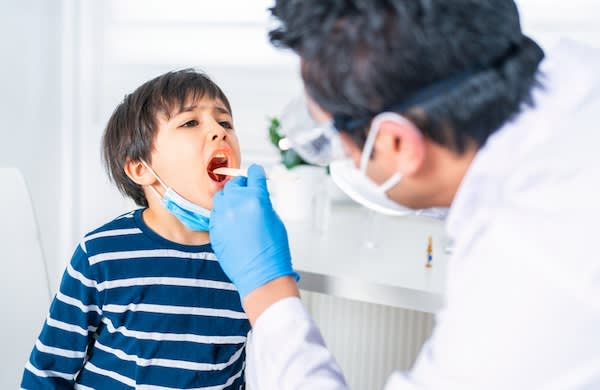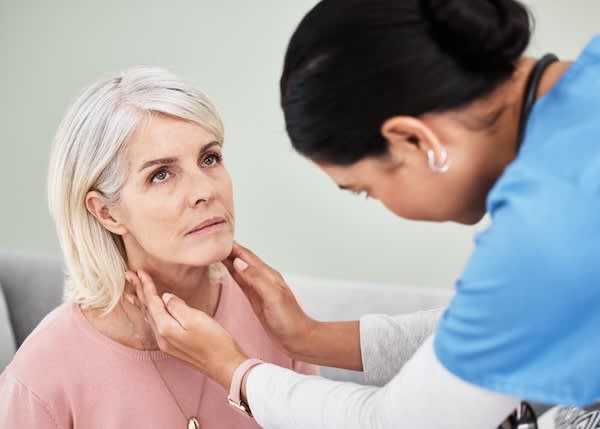Learn the common signs of testicular cancer
[5 MIN READ]
In this article:
-
Testicular cancer is most likely to affect men between the ages of 20 and 35.
-
The best way to find testicular cancer is for young men to perform monthly self-examinations.
-
Researchers are developing a new blood test that will show just how serious a specific cancer is.
Unlike many of the other, more common types of cancer, a man’s risk of testicular cancer doesn’t increase as he ages. Rather, the men who are most in danger of developing testicular cancer are those who are ages 20-35.
“Older men can certainly have other problems in their testicular area,” says Ramkishen Narayanan, M.D., a urologic oncologist at the Center for Urologic Health at the Disney Family Cancer Center – Burbank in Burbank, California. “But testicular cancer in particular occurs mostly in younger men.”
Testicular cancer awareness
April is Testicular Cancer Awareness Month, and awareness is, indeed, the best weapon against the disease. Most testicular cancers are discovered by men, not by their doctors. That’s why it’s so important for men, specifically in the testicular cancer age risk group, to perform testicular self-examinations every month, says Dr. Narayanan. “Most men may not realize the importance of a testicular self-examination, but it’s an easy way to keep yourself healthy,” he says.
How to perform a testicular self-exam
When conducting a self-exam, you should feel for a lump that wasn’t present before. Most often, Dr. Narayanan says, tumors are painless lumps. You may also notice some enlargement or that your testicle has become swollen.
“The best time to do a self-exam is after a shower when the scrotum is relaxed,” says Dr. Narayanan. “The testicle should feel spongy and rubbery, like the soft part of your hand when you make a fist. If anything feels like a knuckle when you make a fist, that’s worrisome.”
Additional symptoms that may indicate testicular cancer include:
- A dull ache in the testicles.
- A pain in the lower back.
- Growth in the breasts.
It is important to note that there are infections that can cause pain, which can be a dull, uncomfortable ache, or more severe, like trauma to the groin. However, he says, a painless lump or pain that doesn’t go away should get your attention.
When that is the case, men should see their health care provider.
Risk factors for testicular cancer
Men at the highest risk of developing testicular cancer are those who:
- Have an undescended testicle.
- Have a personal or family history of testicular cancer.
- Have an HIV infection.
In addition, the risk of developing testicular cancer is four to five times higher for white men than it is for African American or Asian men.
Statistics about testicular cancer
Fortunately, testicular cancer is a fairly rare disease. According to the National Cancer Institute, part of the National Institutes of Health, about 5.7 out of every 100,000 men develop testicular cancer each year. It accounts for about 0.5 percent of all new cancer cases.
Even when it becomes fairly advanced, it’s highly treatable. And more than 95 percent of the men who develop testicular cancer survive five years or longer.
Yet, testicular disease remains mysterious. Researchers aren’t sure what causes it, nor can they explain with certainty why there has been an uptick in the number of cases over the last decade.
New ways to diagnose testicular cancer
One of the bigger challenges with testicular cancer is diagnosing it, because doctors are unable to perform a biopsy on testicular tissue. Instead, they must rely on three separate blood tests (AFP, beta-HCG and LDH) to make an accurate diagnosis.
However, researchers are actively developing newer, more precise ways of diagnosing testicular cancer. One promising modality is through microRNA, such as miRNA 371. MiRNA is defined as small molecules of RNA (ribonucleic acid) with biological activity that are released into biological fluids by testicular cancer cells. Through a simple blood test, doctors can look for miRNA to see if there’s cancer.
“The hope is that we can use microRNA to better detect testicular germ cell tumors and monitor treatment response,” says Dr. Narayanan. “This is a really exciting development for this area of medicine.”
Hope for men with testicular cancer
Dr. Narayanan stresses that while testicular cancer is serious, we are fortunate enough to have plenty treatment options, including surgery, chemotherapy and radiotherapy. “It’s really important to understand that this is a curable disease,” he says. “In fact, with early detection, it is 100% curable.”
He notes that in today’s proactive health care environment, men are more likely to get evaluated when they notice something is wrong with their testicles. That’s why self-exams are so important.
And, even when a man notices something is off, it may not be as concerning as they think. In some cases, a scrotal ultrasound reveals that a man has testicular microlithiasis — a condition in which small clusters of calcium form in the testicles. “It does not mean you have testicular cancer,” he says.
If you are a man between the ages of 20 and 35 and you are unsure how to start self-screenings for testicular cancer, talk to your doctor.
Contributing caregiver
Ramkishen Narayanan, M.D., is a urologic oncologist at the Center for Urologic Health at the Disney Family Cancer Center – Burbank in Burbank, California.
Find a doctor
If you are looking for a Providence urologist, you can search for one who’s right for you in our provider directory.
Download the Providence app
We’re with you, wherever you are. Make Providence’s app your personalized connection to your health. Schedule appointments, conduct virtual visits, message your doctor, view your health records and more. Learn more and download the app.
Related resources
Leading the way in cancer detection
Men: It’s time to take charge of your health
Answering men’s prostate cancer questions
This information is not intended as a substitute for professional medical care. Always follow your health care professional’s instructions.





